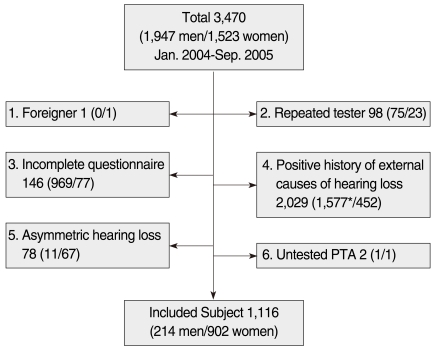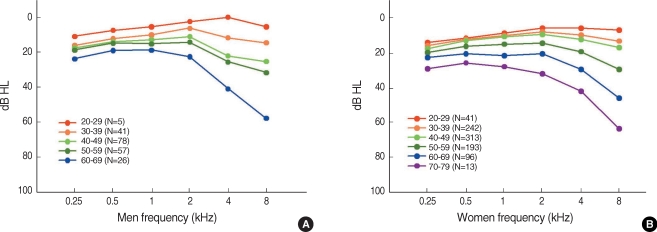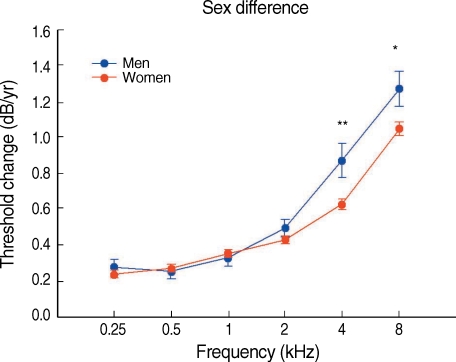Clin Exp Otorhinolaryngol.
2010 Mar;3(1):27-31.
Sex Differences in a Cross Sectional Study of Age-related Hearing Loss in Korean
- Affiliations
-
- 1Department of Otolaryngology, Daegu Fatima Hospital, Daegu, Korea. sungheekim@fatima.or.kr
- 2Department of Control and Instrumentation, Robotics Engineering, Chosun University, Gwangju, Korea.
- 3Department of Otolaryngology, Kyungpook National University, Daegu, Korea.
Abstract
OBJECTIVES
The purpose of this study was to obtain sex- and age-specific reference level for hearing threshold of normal aging in Korean and to determine if the rate of change in pure-tone hearing thresholds differed by sex.
METHODS
Subjects were clients who visited the Health Promotion Center, Daegu Fatima Hospital, Daegu, Korea, from January 2004 to September 2005. Pure-tone audiometric measures were obtained from 3,470 subjects who also completed a hearing questionnaire. The slope of a linear regression was used to estimate the rate of change in pure-tone thresholds at 0.25 to 8 kHz for each ear in 214 men and 902 women without past history of otorrhea, usage of ototoxic drugs, head injury, job in noisy environment, and military service.
RESULTS
Hearing thresholds were elevated with age in all test frequencies. Significant sex differences were found in pure-tone thresholds at 4 and 8 kHz after adjusting for age using analysis of covariance. In those high frequencies, hearing was worse in men than in women. The average rate of change in threshold was 0.28 and 0.24 dB per year at 0.25 kHz, increasing gradually to 1.27 and 1.05 dB per year at 8 kHz for men and women, respectively. Men had significantly faster rates of threshold increase at 4 and 8 kHz than women.
CONCLUSION
These cross-sectional measures of hearing levels and rate of threshold increases at 4 and 8 kHz showed significant sex differences in Korean men and women with little evidence of noise-induced hearing loss.
Keyword
MeSH Terms
Figure
Reference
-
1. Helfer KS. Gender, Age, and Hearing. Seminars in Hearing. 2001; 22(3):271–286.
Article2. Gates GA, Cooper JC Jr, Kannel WB, Miller NJ. Hearing in the elderly: the Framingham cohort, 1983-1985. Part I. Basic audiometric test results. Ear Hear. 1990; 8. 11(4):247–256. PMID: 2210098.3. Jonsson R, Rosenhall U. Hearing in advanced age: a study of presbyacusis in 85-, 88- and 90-year-old people. Audiology. 1998; Jul–Aug. 37(4):207–218. PMID: 9723767.
Article4. Berger EH, Royster LH, Thomas WG. Hearing levels of nonindustrial noise exposed subjects. J Occup Med. 1977; 10. 19(10):664–670. PMID: 903841.5. Megighian D, Savastano M, Salvador L, Frigo A, Bolzan M. Audiometric and epidemiological analysis of elderly in the Veneto region. Gerontology. 2000; Jul–Aug. 46(4):199–204. PMID: 10859459.
Article6. Jonsson R, Rosenhall U, Gause-Nilsson I, Steen B. Auditory function in 70- and 75-year-olds of four age cohorts: a cross-sectional and timelag study of presbyacusis. Scand Audiol. 1998; 27(2):81–93. PMID: 9638827.7. Moller MB. Hearing in 70 and 75 year old people: results from a cross sectional and longitudinal population study. Am J Otolaryngol. 1981; 2. 2(1):22–29. PMID: 6972711.8. Pedersen KE, Rosenhall U, Moller MB. Changes in pure-tone thresholds in individuals aged 70-81: results from a longitudinal study. Audiology. 1989; 28(4):194–204. PMID: 2665703.
Article9. Jerger J, Chmiel R, Stach B, Spretnjak M. Gender affects audiometric shape in presbyacusis. J Am Acad Audiol. 1993; 1. 4(1):42–49. PMID: 8422482.10. Pearson JD, Morrell CH, Gordon-Salant S, Brant LJ, Metter EJ, Klein LL, et al. Gender differences in a longitudinal study of age-associated hearing loss. J Acoust Soc Am. 1995; 2. 97(2):1196–1205. PMID: 7876442.
Article11. Chung TI. An audiological survey of presbycusis. Korean J Otolaryngol. 1969; 12(3):31–40.12. Kim HN, Kim SG, Lee HK, Ohrr H, Moon SK, Chi J, et al. Incidence of presbycusis of Korean populations in Seoul, Kyunggi and Kangwon provinces. J Korean Med Sci. 2000; 10. 15(5):580–584. PMID: 11068997.
Article13. Choi IS, Han YH, Jun BH. An audiologic study of presbycusis. Korean J Audiol. 1997; 1(2):149–154.14. Rha KS, Park CI. Audiologic study of presbycusis. Korean J Otolaryngol. 1982; 25(4):632–640.15. Lee JH, Kim JS, Oh SY, Kim KS, Cho SJ. Effects of age on hearing thresholds for normal adults. Korean J Audiol. 2003; 6. 7(1):15–23.16. Kim SH, Jarng SS, Shin JH, Yoe CK, Han YK, Lee JK. Age- and gender-specific reference levels for hearing thresholds of normal aging in Korean. J Acoust Soc Korea. 2005; 8. 24(6):353–357.17. Brant LJ, Fozard JL. Age changes in pure-tone hearing thresholds in a longitudinal study of normal human aging. J Acoust Soc Am. 1990; 8. 88(2):813–820. PMID: 2212307.
Article18. Corso JF. Age and sex differences in pure-tone thresholds: survey of hearing levels from 18 to 65 years. Arch Otolaryngol. 1963; 4. 77:385–405. PMID: 14041404.
Article19. Kell RL, Pearson JC, Taylor W. Hearing thresholds of an island population in North Scotland. Int J Audiol. 1970; 9(2-4):334–339.
Article20. Moscicki EK, Elkins EF, Baum HM, McNamara PM. Hearing loss in the elderly: an epidemiologic study of the Framingham Heart Study Cohort. Ear Hear. 1985; Jul–Aug. 6(4):184–190. PMID: 4043571.
- Full Text Links
- Actions
-
Cited
- CITED
-
- Close
- Share
- Similar articles
-
- Noise-Induced and Age-Related Hearing Loss in Korea
- A Study on the Influences of Noise Induced Hearing Loss to the Blood Pressure
- Vegetable and Nut Food Groups are Inversely Associated with Hearing Loss- a Cross-sectional Study from the Korea National Health and Nutrition Examination Survey
- Rehabilitation of Age-Related Hearing Loss Patients
- A Cross-Sectional Study of the Time of Onset of Hearing Loss in Bus Drivers Following Exposure to Occupational Noise




